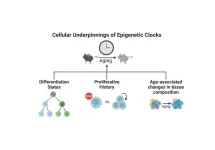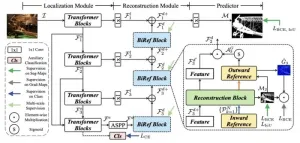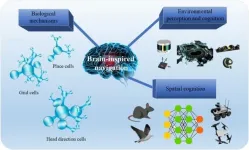(Press-News.org) Tens of millions of Americans are being exposed to tobacco content on streaming services, according to new research from The University of Texas MD Anderson Cancer Center. The researchers found that the odds of encountering tobacco products being advertised, marketed or promoted on these platforms increased based on race, ethnicity, socioeconomic status and smoking habits.
The nationally representative study, published today in JAMA Network, revealed an estimated 12.4% of American adults were exposed to tobacco promotion on streaming services. Exposure was highest among those with a high school education or less (16.4%), Black/African American respondents (19.4%), Hispanic respondents (16.4%), those with an annual household income less than $20,000 (17.6%), and current smokers (17%).
"When viewers see a character smoking, vaping or using tobacco in any form, it can reduce the stigma associated with these behaviors," said lead author Sanjay Shete, Ph.D., professor of Biostatistics and Epidemiology. "If a hero or main character smokes, it can subconsciously signal that it's acceptable, leading some, including America’s youth, to take the first step on the path to smoking."
The respondents, chosen from the National Cancer Institute’s Health Information National Trends Survey (conducted March 7- November 8, 2022) were asked if they had noticed or heard any tobacco products being advertised, marketed or promoted on television or streaming platforms (including Netflix and Hulu) over a three-month period. Over 90% of survey participants responded to this question.
The World Health Organization recommends a complete ban on all forms of tobacco advertising and promotion. While cigarette advertisements on traditional television and radio have been banned in the U.S. since the 1970s, these regulations do not extend to portrayals of tobacco in modern streaming content. Shete notes concerns that this gap may allow tobacco companies to subtly target and influence vulnerable populations while circumventing existing restrictions.
“As these popular platforms continue to dominate the entertainment space, it becomes increasingly important to consider regulations for this content, especially given the potential for exploitation,” Shete said. “These types of public health interventions can contribute to a healthier and more equitable society by preventing individuals from engaging in behaviors that can increase their risk of cancer and other diseases.”
Limitations of the study include low-response bias associated with population-based surveys, lack of data on the duration of exposure to the tobacco content, the subjective nature of the questionnaire and not including Americans younger than 18.
Given that streaming platforms use limited ads and prohibit tobacco advisements, most reported exposures are likely due to tobacco use depictions in shows and movies. This type of promotion is difficult to regulate, as it is unclear whether tobacco companies fund such depictions, or if they constitute artistic choices made by content creators.
The research was funded by the National Cancer Institute (P3OCA016672), the Betty B. Marcus Chair in Cancer Prevention, and the Duncan Family Institute for Cancer Prevention and Risk Assessment. A full list of collaborating authors and their disclosures can be found here.
Read this press release in the MD Anderson Newsroom.
END
Americans face disparities in exposure to tobacco on streaming platforms
First-of-its-kind study reveals viewers from minority groups, current smokers and those with lower education or income levels are more likely to encounter tobacco-related programming
2024-08-22
ELSE PRESS RELEASES FROM THIS DATE:
Elinzanetant for the treatment of vasomotor symptoms associated with menopause
2024-08-22
About The Study: In two pivotal phase 3 clinical trials, elinzanetant, a selective neurokinin-1,3 receptor antagonist, demonstrated statistically significant reductions in vasomotor symptoms (VMS) frequency and severity vs placebo in postmenopausal individuals with moderate to severe VMS. Elinzanetant also significantly improved sleep disturbances and menopause-related quality of life vs placebo; the safety profile was favorable.
Corresponding Author: To contact the corresponding author, JoAnn V. Pinkerton, ...
Trends in children’s exposure to food and beverage advertising on television
2024-08-22
About The Study: In this repeated cross-sectional study of children’s exposure to food-related television advertisements, exposure via children’s programming decreased substantially. However, most advertisements seen were still for unhealthy products, and exposure from all programming remained substantial. Findings of more than 90% of advertising exposure not from children’s programming and more than 1,000 food-related advertisements seen per year suggest the need for government regulations based on time of day rather than programming.
Corresponding Author: To contact the corresponding author, Lisa M. Powell, PhD, email powelll@uic.edu.
To ...
Disparities in exposure to tobacco on television or streaming platforms
2024-08-22
About The Study: In this study of the prevalence of exposure to tobacco advertisements on TV or streaming platforms among U.S. adults, disparities in exposure by race or ethnicity, education level, and smoking status were identified. These findings underscore the need for targeted public health interventions and regulation to address these disparities and reduce the impact of tobacco advertisements on vulnerable populations.
Corresponding Author: To contact the corresponding author, Sanjay Shete, PhD, email sshete@mdanderson.org.
To access the embargoed study: Visit our For The Media website at this link https://media.jamanetwork.com/
(doi:10.1001/jamanetworkopen.2024.27781)
Editor’s ...
How thyroid hormone fuels the drive to explore
2024-08-22
Thyroid hormone plays a key role in regulating a range of physiologic functions, including metabolism, temperature, heart rate, and growth. It accomplishes this impressive array of activities by interacting with almost every organ system in the body. Yet despite a long history of research on how thyroid hormone influences different organs, its effects on arguably the most crucial organ — the brain — have remained shrouded in mystery.
Now, scientists at Harvard Medical School have gained ...
Higher thiazide doses shown to reduce kidney stone events
2024-08-22
Higher thiazide doses are associated with greater reductions in urine calcium, which in turn correlate with fewer symptomatic kidney stone events, according to a Vanderbilt University Medical Center (VUMC) study published in JAMA Network Open.
Thiazide diuretics, commonly prescribed to prevent kidney stone recurrence, are drugs that act directly on the kidneys to promote diuresis (urine flow) by inhibiting the sodium/chloride cotransporter located in the distal convoluted tubule of a nephron ...
Reading your biological age in your blood or saliva? It’s not as simple as that
2024-08-22
How old are you, really? Your chronological age is the number of years you have been alive. Your biological age is how old your cells are which scientists believe may better assess one’s age-related health and disease risk. People biologically age at different rates, depending on genetic and environmental factors, so that a person’s chronological age does not necessarily match their biological age. In recent years, direct-to-consumer biological age tests have become increasingly accessible and popular as interest has increased ...
Pong prodigy: Hydrogel material shows unexpected learning abilities
2024-08-22
In a study published today (22 August) in Cell Reports Physical Science, a team led by Dr Yoshikatsu Hayashi demonstrated that a simple hydrogel - a type of soft, flexible material - can learn to play the simple 1970s computer game ‘Pong’. The hydrogel, interfaced with a computer simulation of the classic game via a custom-built multi-electrode array, showed improved performance over time.
Dr Hayashi, a biomedical engineer at the University of Reading’s School of Biological Sciences, said: "Our research shows that even very simple materials can exhibit complex, adaptive behaviours typically associated with living systems or sophisticated AI.
"This ...
AI can speed up drug development
2024-08-22
Artificial intelligence (AI) can help identify molecules that could serve as new drugs for mental health disorders. AI can be used to predict the three-dimensional structures of important receptors and thereby speed up the development of potential drugs. This is the result of a new study from Uppsala University published in Science Advances.
In drug development, experimental methods are often used to determine the three-dimensional structures of target proteins and to understand how molecules bind to them. This information is needed to design drug molecules efficiently. However, the process to determine structures can be demanding, meaning this ...
Bilateral reference framework for high-resolution dichotomous image segmentation
2024-08-22
A research team has developed a computer vision technique that can perform dichotomous image segmentation, high-resolution salient object detection, and concealed object detection in the same framework. Their novel bilateral reference framework (BiRefNet) is able to capture tiny-pixel features and holds potential for a wide range of practical computer vision applications.
The work is published in the journal CAAI Artificial Intelligence Research on August 22.
In computer vision research, ...
The future of robotics: Brain-inspired technologies paving the way
2024-08-22
In the ever-evolving field of robotics, a groundbreaking approach has emerged, revolutionizing how robots perceive, navigate, and interact with their environments. This new frontier, known as brain-inspired navigation technology, integrates insights from neuroscience into robotics, offering enhanced capabilities and efficiency.
Brain-inspired navigation technologies are not just a mere improvement over traditional methods; they represent a paradigm shift. By mimicking the neural mechanisms of animals, these technologies provide robots with the ability to navigate through complex and unknown terrains with unprecedented accuracy ...
LAST 30 PRESS RELEASES:
Do our body clocks influence our risk of dementia?
Anthropologists offer new evidence of bipedalism in long-debated fossil discovery
Safer receipt paper from wood
Dosage-sensitive genes suggest no whole-genome duplications in ancestral angiosperm
First ancient human herpesvirus genomes document their deep history with humans
Why Some Bacteria Survive Antibiotics and How to Stop Them - New study reveals that bacteria can survive antibiotic treatment through two fundamentally different “shutdown modes”
UCLA study links scar healing to dangerous placenta condition
CHANGE-seq-BE finds off-target changes in the genome from base editors
The Journal of Nuclear Medicine Ahead-of-Print Tip Sheet: January 2, 2026
Delayed or absent first dose of measles, mumps, and rubella vaccination
Trends in US preterm birth rates by household income and race and ethnicity
Study identifies potential biomarker linked to progression and brain inflammation in multiple sclerosis
Many mothers in Norway do not show up for postnatal check-ups
Researchers want to find out why quick clay is so unstable
Superradiant spins show teamwork at the quantum scale
Cleveland Clinic Research links tumor bacteria to immunotherapy resistance in head and neck cancer
First Editorial of 2026: Resisting AI slop
Joint ground- and space-based observations reveal Saturn-mass rogue planet
Inheritable genetic variant offers protection against blood cancer risk and progression
Pigs settled Pacific islands alongside early human voyagers
A Coral reef’s daily pulse reshapes microbes in surrounding waters
EAST Tokamak experiments exceed plasma density limit, offering new approach to fusion ignition
Groundbreaking discovery reveals Africa’s oldest cremation pyre and complex ritual practices
First breathing ‘lung-on-chip’ developed using genetically identical cells
How people moved pigs across the Pacific
Interaction of climate change and human activity and its impact on plant diversity in Qinghai-Tibet plateau
From addressing uncertainty to national strategy: an interpretation of Professor Lim Siong Guan’s views
Clinical trials on AI language model use in digestive healthcare
Scientists improve robotic visual–inertial trajectory localization accuracy using cross-modal interaction and selection techniques
Correlation between cancer cachexia and immune-related adverse events in HCC
[Press-News.org] Americans face disparities in exposure to tobacco on streaming platformsFirst-of-its-kind study reveals viewers from minority groups, current smokers and those with lower education or income levels are more likely to encounter tobacco-related programming





